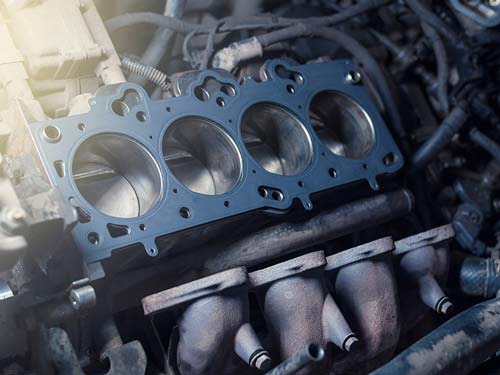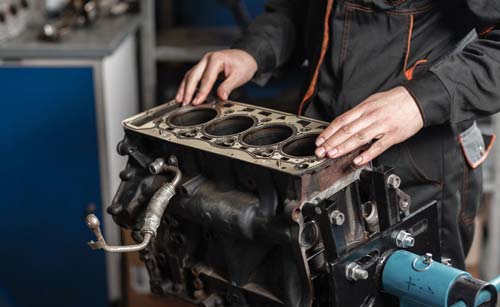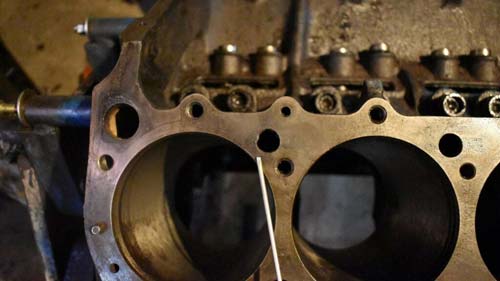If you’re a car owner, you should already know that your car needs regular maintenance to function properly for a long time. Oil changes, tire rotations, and air filter replacement are just a few common repairs needed. However, even if your vehicle has been well-maintained, certain components may begin to fail as it ages.
You’ll have to replace the serpentine belt eventually if you own your vehicle long enough. Timing belts will need to be replaced at some point. The head gasket is another component that will ultimately break. Unfortunately, a blown head gasket may cause severe issues and be costly to fix.
Have you ever had a blown head gasket? Or is your car showing any symptoms of a blown head gasket? In this blog post, we’ll look at what’s causing the problem, how to fix it, how much a repair will cost, and what your best choices are for moving ahead. We’ll also answer some of the related questions you may ask on the internet.
So, let’s get started!
Table of Contents
What Is The Head Gasket & What Does It Do?
The cylinder block, which houses the pistons and cylinders, and the cylinder head, which houses the valves, spark plugs, and camshaft(s), are the two components of your car’s engine. The head gasket is sandwiched between these two large engine components. It is the engine’s most strained gasket, and therefore one of the most prone to break.

The head gasket is one of the most essential gaskets in your engine because it seals the cylinders’ firing pressure and prevents coolant and engine oil from escaping into the cylinders and out to the outside. It allows the combustion process to take place safely inside the cylinder. You won’t be able to start the engine until you have a properly sealed gasket in place.
Older cars use composite head gaskets, which are composed of materials like asbestos and graphite. This gasket is probably the least dependable and is considerably more prone to blowouts than other materials. Fortunately, they are no longer in use, so you shouldn’t have any problems if you have a modern vehicle.
5 Signs That Your Head Gasket Is Blown
These 5 signs will tell you that your head gasket is blown or about to blow.
#1. Hot Engine
A blown head gasket will almost always cause the engine to overheat. A blown head gasket will only prevent an engine from overheating if it explodes between two cylinders without disrupting coolant or oil flow. Otherwise, mixing oil and coolant compromises the lubricating and cooling systems, causing temperatures to increase.
The most essential thing to remember is that you should not continue driving if your engine begins to overheat. Pullover, let it cool off, and make an appointment with the specialists.
#2. Oil Contamination
If you think your engine’s head gasket has blown, you may easily confirm your suspicions by looking beneath the oil filler cap. The interior of the oil cap should be reasonably dry if the gasket is intact, with a small amount of engine oil on the inside. You may have a head gasket leak if you see a milky brownish-yellow material, a chocolate milkshake’s color, and consistency.
This milky material is oil mingled with coolant and pollutes the engine oil as it seeps past the head gasket. Because contaminated engine oil can’t effectively protect your engine from friction or heat, you may need to replace your head gasket right immediately.
#3. Blowing Smoke
The head gasket aids in coolant flow via the engine’s coolant channels located directly next to the combustion chambers. Coolant may flow into the combustion chambers and be burnt with the fuel if the head gasket fails. Coolant burns in the engine and produces a white or grey-colored smoke that escapes out the exhaust.
When many vehicles produce visible tailpipe smoke while warming up on a chilly day, a car that emits visible smoke all the time is likely suffering from a head gasket problem.
#4. Loss Of Power
If you stepped on the gas and everything seemed normal until you abruptly lost power, the head gasket may have ruptured. It’s possible that this didn’t happen when you were driving. You may have just gotten into your car to go to work one morning and felt as though it had lost its power.
This occurs when the head gasket between the cylinders breaks in many instances, resulting in neither cylinder having enough compression to generate power.
#5. External Leaks Or Radiator Bubbles
Bubbles are fun in a fish tank or at a child’s birthday party, but they shouldn’t be in your car’s radiator. Your car’s engine coolant system is intended to be a closed system with air pockets only at the top of the radiator or overflow tank. If bubbles appear in any of these, you might have a problem.
The combustion chambers are the most probable source of this air, which indicates a blown head gasket. Between the cylinder head and the engine block, a lot happens.
Understand Head Gasket Replacement & Repair Costs
The head gasket itself is a basic and inexpensive component. New head gaskets don’t cost more than $100, and most are much less. However, due to the work required, repairing a head gasket may be very costly.
To get to the damaged gasket in an engine with a blown head gasket issue, you must nearly fully dismantle the engine and remove the cylinder head from the block. In the worst-case situation, the blown head gasket causes severe damage to the cylinders, cylinder heads, or other components, necessitating their replacement.

Replacing or repairing an engine with a blown head gasket is an expensive and time-consuming process that may take several days. Also, keep in mind that if you have a V6, V8, V12, or a boxer-type engine, you’ll have to perform twice the labor since there are two-cylinder heads to deal with.
In summary, the total cost may vary considerably depending on the model of your car, the country you’re in, the level of damage, and the repair shop you’re going to (Yes, some charge more than others). However, if you want an exact estimate, expect to spend between $1000 and $2000 for the complete repair.
How can I lower the average cost of repair?
In most instances, the cost of replacing a head gasket will be cheaper if you discover the issue early enough, as it is with most other problems. It’s unlikely to be as severe if you catch it early. A head gasket leak repair is usually less expensive than a complete head gasket replacement.
Keep in mind that replacing an engine is more expensive than repairing a leaking head gasket. The labor cost of replacing an engine is also greater than repairing a leaky head gasket.
Should I replace my car’s head gasket?
The decision of whether to replace your head gasket boils down to the worth of your car. If your vehicle is worth a lot of money, replacing the head gasket is usually a good idea. However, changing the head gasket on an old car is a waste of money.
How To Fix A Blown Head Gasket Without Replacing It?
Many people wonder whether a blown or leaking head gasket may be repaired rather than replaced entirely. Yes, it is possible! However, this will only apply in certain circumstances. That’s why, if you see any of the signs of a burst head gasket, you should pull over immediately.
If you’re going to try to repair the head gasket without replacing it, you’ll have to act quickly before further damage is done or the gasket is entirely blown out! If caught early enough, commercial sealants like this one may be used to repair damaged head gaskets without entirely dismantling the engine!
It’s very simple to use these kinds of sealants. In most cases, the sealant will be applied to your radiator or coolant expansion tank. After that, you’ll start the vehicle and let it warm up to normal operating temperature. This will enable the sealant to flow through the engine’s passageways, sealing any potential leaks, including the head gasket.
This may be an excellent alternative to replacing the head gasket if detected early enough. It’s also a lot less costly, so it relieves some of the financial strain! At least, it’s worth a try before you take your precious car to the mechanics.
4 Reasons Your Car May Still Overheat After Head Gasket Replacement
The procedure for removing the head gasket differs based on the type of your vehicle. Because it requires removing a significant number of engine components, getting to the gasket may be a long process. The complete specifics of which may usually be found in the service handbook for your car.
Because of this extensive process, your car may show some problems even after replacing the head gasket. Here are 4 reasons –
#1. Mechanics may make a mistake
Replacing the head gasket necessitates dismantling most of the engine, which requires a high level of expertise. If you had your head gasket replaced by an independent technician, the mechanic might have overlooked something while reassembling the engine. If the engine block and cylinder head are not deformed, a new head gasket will not work.
#2. A crooked cylinder head or an engine block
The head gasket connects the cylinder head to the engine block, and if one of these pieces is warped, changing the gasket won’t help much. It’s most likely the cylinder head if just one component is bent. The engine will need to be machined and then reinstalled to prevent it from continuing to overheat.
#3. The water pump needs replacement
Of course, the head gasket may not have been the only source of the issue. A faulty water pump, for example, maybe to cause. The water pump should be changed at the same time as the head gasket on your car. Your engine will continue to overheat if your water pump fails.
#4. Timing issues
Timing issues may cause the engine to overheat in the first place. A mechanic who fails to correctly reassemble the engine after changing a head gasket may create timing issues by inadvertently messing up the firing sequence. In any event, having your car repaired by factory-certified experts is recommended.
If your vehicle continues to overheat after the head gasket has been changed, pull over immediately to avoid additional damage. Otherwise, the car would continue to overheat, perhaps blowing the new head gasket as well! If you detect any of these problems, locate a nearby technician as soon as possible.
How to Avoid a Blown Head Gasket Altogether?

When it comes to head gaskets, prevention is much better than cure. There are things you can do to avoid dealing with the expense of a blown head gasket down the road.
- Keep an eye on the temperature of the engine. If your car’s temperature gauge is consistently in the red, get it checked out straight immediately. You’re more prone to burst a head gasket if your vehicle runs heated for a long time.
- Keep an eye on your car’s oil and coolant levels. Make sure you follow the instructions in your owner’s handbook and buy the appropriate type of oil and coolant for your vehicle. This will prolong the life of all of your internal components, and keeping a watch on the leaves may aid in the detection of leaks.
- If your car’s engine is misfiring, have it evaluated and repaired as quickly as possible. Misfires may deteriorate a head gasket considerably more rapidly than regular wear and tear.
- Don’t forget to get those oil changes! Many drivers ignore this for a long time, but there’s a reason your handbook says you should replace your oil after a specific number of miles. To prolong the life of all components of your engine, including the head gasket, adhere to it as strictly as possible.
Frequently Asked Questions
1. Does head gasket sealer really work?
There’s both good news and bad news. The bad news is that head gasket sealers, for the most part, do not function. Even when they work, they are never a long-term solution. Another thing to consider is that whether the head gasket sealer will work depends entirely on how the head gasket broke.
For example, the head gasket sealer will not function if your engine overheated and the head gasket leak occurs. If your vehicle did not overheat and the leak is between the combustion chamber and the cooling system, this temporary repair may help.
2. Is head gasket repair expensive?
As you’ve already seen, head gasket repairs may cost thousands of dollars. This may often mean that buying a new vehicle is more convenient and cost-effective than having the old one fixed. Not only are head gasket replacement components costly, but so is the labor.
3. How long can you drive with a head gasket leak?
A blown head gasket can cause severe problems in your vehicle. The failure of other components in your engine may occur. It’s critical to pull over as soon as you suspect this is the case. Continued operation will only worsen the damage to your engine. Any car owner does not want to have to replace their car’s engine.
4. How long will a head gasket last?
To get the most out of a head gasket, ensure your engine and cooling system is in good operating order. If the engine runs cool and smooth, the head gasket should last the same time as the engine. In 2021, this implies that the head gasket might last 200,000 miles or more than ten years.
Final Words
Blown head gaskets are no joke, and your car’s engine will not survive long if you have one. A head gasket repair or replacement is costly; therefore, it may not make sense to invest that much money in your car.
Many car owners do not have that sort of money set up for unexpected expenditure. In such situations, you’d be better off selling your vehicle and buy a new one.
